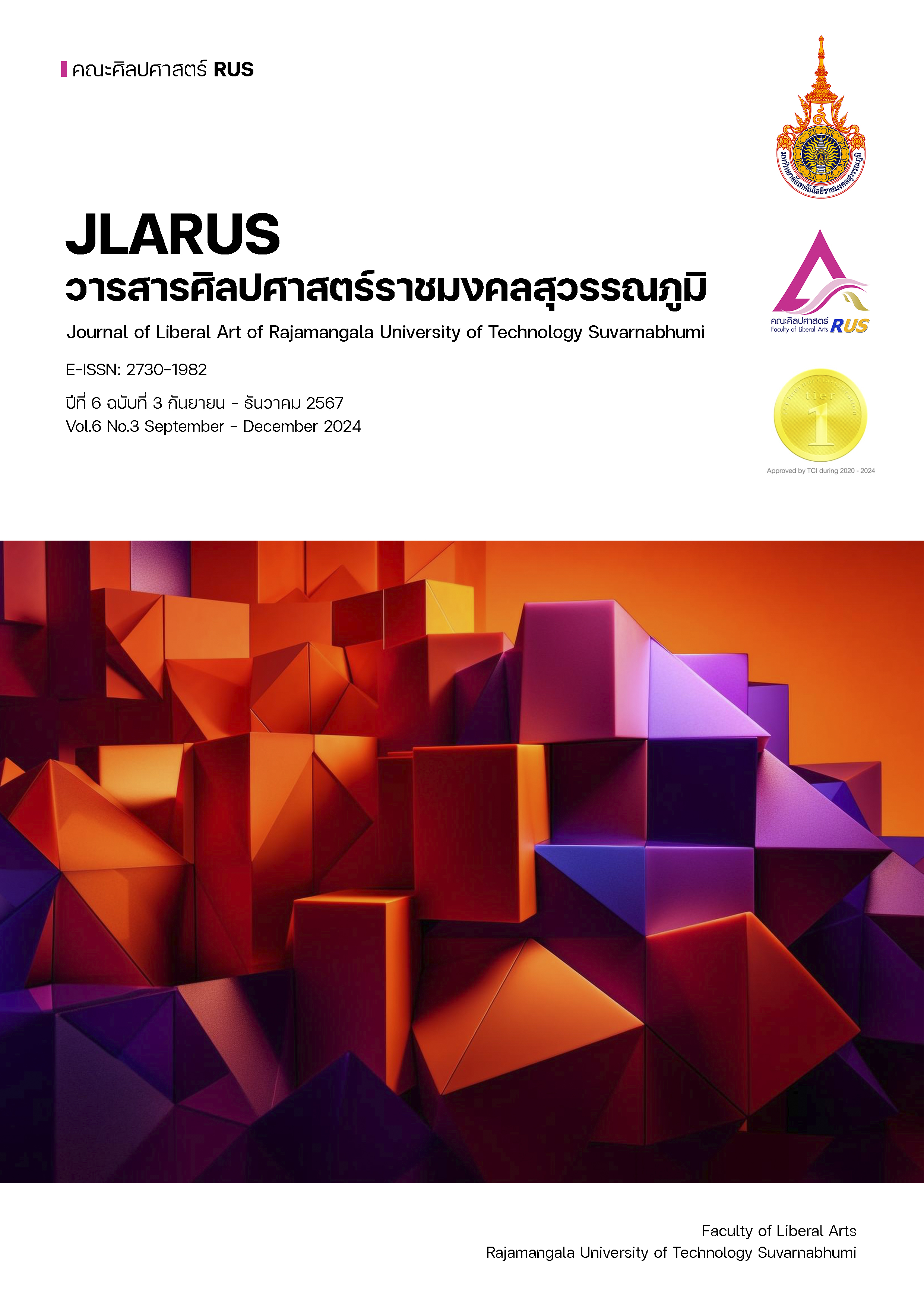NONG YA PLONG COMMUNITY: SWOT AND TOWS MATRIX ANALYSIS FOR CREATING A MARKETING PROMOTION STRATEGY
Main Article Content
Abstract
The use of knowledge and resources in production areas as products and services can create a foundation economy and distribute income to communities. This research is a qualitative case study focusing on examining product distribution and the community environment using SWOT to develop marketing strategies. The informants were 15 housewives from the Nong Ya Plong community group that processes fruit and herbal juices, including the group leader, group committee members, and group members, selected through purposive sampling. The research tools were in-depth interviews and record-based SWOT analysis. Data were gathered through informal in-depth interviews and brainstorming sessions and were analyzed using content analysis, data triangulation, and SWOT analysis by averaging and ranking each item in the TOWS Matrix analysis. The results showed that: 1) Regarding the channels and methods of distribution based on the theory of marketing promotion mix, the group communicates information to customers through their Facebook page and village LINE group. There is also word-of-mouth publicity and sales promotions offering discounts on products when a certain amount is purchased. 2) The SWOT analysis of strengths, weaknesses, opportunities, and threats, together with the TOWS Matrix analysis, yielded seven marketing strategies, starting with analyzing consumer behavior to use as a guideline for food product development and ending with developing marketing channels with online marketing innovations. The recommendations are to create a mentoring community in order to share experiences in product development and marketing, supported by local authorities, and to leverage community innovators to help improve the group’s operations. This study will serve as a guideline to help increase the potential of communities to create and distribute income within their community.
Article Details

This work is licensed under a Creative Commons Attribution-NonCommercial-NoDerivatives 4.0 International License.
References
กัลยารัตน์ หัสโรค์. (2565). กลยุทธ์การตลาดออนไลน์ที่มีอิทธิพลต่อความสำเร็จของผู้ประกอบการที่ ได้รับรองคุณภาพผลิตภัณฑ์ชุมชน จังหวัดอุดรธานี. วารสารมนุษยศาสตร์และสังคมศาสตร์ มหาวิทยาลัยมหาสารคาม, 41(6), 7-19.
กาญจนา รอดแก้ว ภุชงค์ เสนานุช และรณรงค์ จันใด. (2564). การศึกษาความคิดเห็นเกี่ยวกับนโยบาย การพัฒนาเศรษฐกิจฐานรากเพื่อการพัฒนาอย่างยั่งยืน. วารสารสถาบันพระปกเกล้า, 19(1), 48-66
ธนภณ นิธิเชาวกุล. (2565). การวิเคราะห์ SWOT Analysis กับสถิติ. วารสารคุณภาพชีวิตกับกฎหมาย, 18(1), 108-120.
บุญชม ศรีสะอาด. (2560). การวิจัยเบื้องต้น. (พิมพ์ครั้งที่ 10). กรุงเทพมหานคร: สำนักพิมพ์สุวีริยาสาส์น.
ปาณิสรา ธรรมโหร และบรรดิษฐ พระประทานพร. (2563). ส่วนประสมทางการตลาดของธุรกิจ ร้านอาหารตามสั่งที่มีอิทธิพลต่อระดับการตัดสินใจเลือกซื้อของลูกค้าในตลาดนัดหลัง กระทรวงการคลัง. วารสารบัณฑิตศึกษา มหาวิทยาลัยราชภัฏสวนสุนันทา, 13(2), 41-56.
วรรณวิสา ไชยหนองเข้ และโชคชัย สุเวชวัฒนกุล. (2567). ปัจจัยส่วนประสมทางการตลาดที่มีผลต่อความจงรักภักดีต่อตราสินค้าในการเลือกพักแรมของนักท่องเที่ยวชาวไทยบริเวณหมู่เกาะล้าน จังหวัด ชลบุรี. วารสารศิลปศาสตร์ราชมงคลสุวรรณภูมิ, 6(2), 301-315.
สำนักงานนโยบายและยุทธศาสตร์การค้า กระทรวงพาณิชย์. (2567). แนวทางการส่งเสริมสินค้าโอทอป. กรุงเทพมหานคร: สำนักงานนโยบายและยุทธศาสตร์การค้า กระทรวงพาณิชย์.
สำนักเลขาธิการนายกรัฐมนตรี. (2565). นโยบายข้อ 7 การพัฒนาสร้างความเข้มแข็งจากฐานราก. สืบค้น 20 เมษายน 2567. จาก https://www.soc.go.th/wp-content/uploads/2022/01/14- นโยบายข้อ7-หน้า-163-180.pdf .
สุภางค์ จันทวานิช. (2553). การวิเคราะห์ข้อมูลเชิงคุณภาพ. กรุงเทพมหานคร: สำนักพิมพ์จุฬาลงกรณ์ มหาวิทยาลัย.
สุระเชษฐ์ สุทธิบุตร พระมหาหรรษา ธมฺมหาโส และพระปราโมทย์ วาทโกวิโท. (2563). การส่งเสริมการ ขายสินค้าชุมชนด้วยการตลาดออนไลน์โดยพุทธสันติวิธี ศึกษากรณีตำบลสวาย อำเภอปรางค์กู่ จังหวัดศรีสะเกษ. วารสารสันติศึกษาปริทรรศน์ มจร, 8 (ฉบับเพิ่มเติม), 172-184.
อนันตพร พุทธัสสะ. (2563). การพัฒนากลยุทธ์การส่งเสริมการตลาดดิจิทัลเพื่อสร้างการได้เปรียบในการ แข่งขันของวิสาหกิจชุมชนในจังหวัดกาฬสินธุ์. วารสารวิชาการเทคโนโลยีการจัดการ, 1(2), 12-21.
Creswell, J. W. (1998). Qualitative inquiry and research design: Choosing among five traditions. Sage Publications.
Hennig-Thurau, T., Malthouse, E. C., Friege, C., Gensler, S., Lobschat, L., Rangaswamy, A, &. Humphrey, A. (2005). SWOT Analysis for Management Consulting, SRI Alumni Newsletter. SRI International. Retrieved September 1, 2023, from https://alumni.sri.com/newsletters/2005/AlumNews-Dec-2005.pdf.
Kerdpitak, C. (2022). Business performance model of herbal community enterprise in Thailand. Uncertain Supply Chain Management, 10(2), 345-352.
Kotler, P., & Keller, K. L. (2012). Marketing management. 14th ed. New York: Pearson Education.
Lester, S. (1999). An Introduction to phenomenological research. Retrieved September 1, 2023, from www.sld.demon.co.uk/resmethy.pdf, accessed [date].
Mahmud, M. S., Islam, M. N., Ali, M. R., & Mehjabin, N. (2024). Impact of electronic word of mouth on customers’ buying intention considering trust as a mediator: A SEM approach. Global Business Review, 25(2_suppl), S184-S198.
Mu'min, H., Telaumbanua, E., Sya’rani, R., Basir, B., & Hasdiansa, I. W. (2024). Building Competitive Advantage: Copra Marketing Strategy with Swot Analysis Approach. Journal Of Economics, Entrepreneurship, Management Business and Accounting, 2(1), 16-28.
Rakhmansyah, M., Wahyuningsih, T., Srenggini, A. D., & Gunawan, I. K. (2022). Small and Medium Enterprises (SMEs) with SWOT Analysis Method. International Journal for Applied Information Management, 2(3), 50–57.
Weihrich, H. (1982). The TOWS matrix-A tool for situation analysis. Long Range Planning, 15(2), 54-66.


